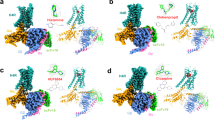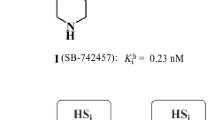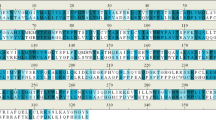Abstract
Astemizole, a H1R antagonist shows high affinity to the histamine H1 receptor but only a moderate affinity to the histamine H4 receptor. This study aims to modify the astemizole to keep high affinity to the histamine H1 receptor and to increase affinity to the histamine H4 receptor. Therefore, 13 astemizole-derived compounds and astemizole-JNJ7777120-derived hybrid compounds were synthesized and pharmacologically characterized at the histamine H1 and H4 receptors. The new compounds show affinity to the histamine H1 receptor in the pK i range from 5.3 to 8.8, whereas the affinity of these compounds to the histamine H4 receptor was surprisingly rather low (pK i from 4.4 to 5.6). Three representative compounds were docked into the histamine H1 receptor and molecular dynamic studies were performed to explain the binding mode and the experimental results on a molecular level. Furthermore, taking into account the binding mode of compounds with high affinity to the histamine H4 receptor, a H1/H4-pharmacophore hypothesis was developed.











Similar content being viewed by others
References
Angel TE, Chance MR, Palczewski K (2009) Conserved waters mediate structural and functional activation of family A (rhodopsin-like) G protein-coupled receptors. PNAS 106:8555–8560
Appl H, Holzammer T, Dove S, Haen E, Strasser A, Seifert R (2012) Interactions of recombinant human histamine H1, H2, H3 and H4 receptors with 34 antidepressants and antipsychotics. Naunyn Schmiedeberg's Arch Pharmacol 385:145–170
Arunlakshana O, Schild HO (1959) Some quantitative uses of drug antagonists. Br J Pharmacol Chemother 14:48–58
Brunskole I, Strasser A, Seifert R, Buschauer A (2011) Role of the second and third extracellular loops of the histamine H4 receptor in receptor activation. Naunyn Schmiedeberg's Arch Pharmacol 384:301–317
Bruysters M, Jongejan A, Gillard M, van de Manakker F, Bakker RA, Chatelain P, Leurs R (2005) Pharmacological differences between human and guinea-pig histamine H1-receptors: Asn84 (2.61) as key residue within an additional binding pocket in the H1-receptor. Mol Pharmacol 67:1045–1052
Cheng Y, Prusoff WH (1973) Relationship between the inhibition constant (K i) and the concentration of inhibitor which causes 50 per cent inhibition (I 50) of an enzymatic reaction. Biochem Pharmacol 22:3099–3108
de Esch IJP, Thurmond RL, Jongejan A, Leurs R (2005) The histamine H4 receptor as a new therapeutic target for inflammation. Trends Pharmacol Sci 26:462–469
Deml KF, Beermann S, Neumann D, Strasser A, Seifert R (2009) Interactions of histamine H1-receptor agonists and antagonists with the human histamine H4-receptor. Mol Pharmacol 76:1019–1030
Elz S, Kramer K, Pertz HH, Detert H, Laak A, Kühne R, Schunack W (2000) Histaprodifens: synthesis, pharmacological in vitro evaluation, and molecular modeling of a new class of highly active and selective histamine H1-receptor agonists. J Med Chem 43:1071–1084
Esbenshade TA, Estvander BR, Miller TR, Baranowski JL, Sharma R, Hancock AA, Krueger KM (2007) Pharmacological classification of histamine H3 receptor agents across species is attributable to transmembrane sequence differences. Inflamm Res 56(suppl 1):S45–S46
Foord SM, Bonner TI, Neubig RR, Rosser EM, Pin JP, Davenport AP, Spedding M, Harmar AJ (2005) International union of pharmacology. XLVI. G protein-coupled receptor list. Pharmacol Rev 57:279–299
Gallois-Bernos AC, Thurmond RL (2012) Alcaftadine, a new antihistamine with combined antagonistic activity at histamine H1, H2, and H4 receptors. J Recept Ligand Channels Res 5:9–20
Garcia-Quiroz J, Camacho J (2011) Astemizole: an old anti-histamine as a new promising anti-cancer drug. Anti Cancer Agents Med Chem 11:307–314
Gillard M, van der Perren C, Moguilevsky N, Massingham R, Chatelain P (2002) Binding characteristics of ceterizine and levoceterizine to human H1 histamine receptors: contribution of Lys191 and Thr194. Mol Pharmacol 61:391–399
Hill SJ, Ganellin CR, Timmermann H, Schwartz JC, Shankley NP, Young JM, Schunack W, Levi R, Haas HL (1997) International union of pharmacology. XIII. Classification of histamine receptors. Pharmacol Rev 49:253–278
Jablonowski JA, Grice CA, Chai W, Dvorak CA, Venable JD, Kwok AK, Ly KS, Wei J, Baker SM, Desai PJ, Jiang W, Wilson SJ, Thurmond RL, Karlsson L, Edwards JP, Lovenberg TW, Carruthers NI (2003) The first potent and selective non-imidazole human histamine H4 receptor antagonists. J Med Chem 46:3957–3960
Janssens F, Torremans J, Janssen M, Stokbroekx RA, Luyckx M, Janssen PA (1985) New antihistaminic N-heterocyclic 4-piperidinamines, 1. Synthesis and antihistaminic activity of N-(4-piperidinyl)-1H-benzimidazol-2-amines. J Med Chem 28:1925–1933
Janssens F, Janssen MAC, Awouters F, Niemegeers CJE, Bussche GV (1986) Chemical development of astemizole-like compounds. Drug Dev Res 8:27–36
Jongejan A, Lim HD, Smits RA, de Esch IJP, Haaksma E, Leurs R (2008) Delineation of agonist binding to the human histamine H4 receptor using mutational analysis, homology modelling, and ab initio calculations. J Chem Inf Model 48:1455–1463
Leurs R, Smit MJ, Tensen CP, ter Laak AM, Timmerman H (1994) Site-directed mutagenesis of the histamine H1-receptor reveals a selective interaction of asparagines207 with subclasses of H1-receptor agonists. Biochem Biophys Res Commun 201:295–301
Lim HD, Jongejan A, Bakker RA, Haaksma E, de Ech IJ, Leurs R (2008) Phenylalanine 169 in the second extracellular loop of the human histamine H4 receptor is responsible for the difference in agonist binding between human and mouse H4 receptors. J Pharmacol Exp Ther 327:88–96
Liu H, Altenbach RJ, Carr TL, Chandran P, Hsieh GC, Lewis LGR, Manelli AM, Milicic I, Marsh KC, Miller TR, Strakhova MI, Vortherms TA, Wakefield BD, Wetter JM, Witte DG, Honore P, Esbenshade TA, Brioni JD, Cowart MD (2008) cis-4-(piperazin-1-yl)-5,6,7a,8,9,10,11,11a-octahydrobezofuro[2,3-h]quinazolin-2-amine (A987306), a new histamine H4R antagonist that blocks pain responses against Carrageenan-induced hyperalgesia. J Med Chem 51:7094–7098
Liu W, Chun E, Thompson AA, Chubukov P, Xu F, Katritch V, Han GW, Roth CB, Heitman LH, Ijzerman AP, Cherezov V, Stevens RC (2012) Structural basis for allosteric regulation of GPCRs by sodium ions. Science 337:232–235
Lovenberg TW, Pyati J, Chang H, Wilson SJ, Erlander MG (2000) Cloning of rat histamine H3 receptor reveals distinct species pharmacological profiles. J Pharmacol Exp Ther 293:771–778
Marson CM (2011) Targeting the histamine H4 receptor. Chem Rev 111:7121–7156
Moguilevsky N, Varsalona F, Noyer M, Gillard M, Guillaume JP, Garcia L, Szpirer C, Szpirer J, Bollen A (1994) Stable expression of human H1-histamine receptor cDNA in Chinese hamster ovary cells. Pharmacological characterization of the protein, tissue distribution of messenger RNA and chromosomal localization of the gene. Eur J Biochem 224:489–495
Nakamura T, Itadani H, Hidaka Y, Ohta M, Tanaka K (2000) Molecular cloning and characterization of a new human histamine receptor, hH4R. Biochem Biophys Res Commun 279:615–620
Neubig RR, Spedding M, Kenakin T, Christopoulos A (2003) International union of pharmacology committee on receptor nomenclature and drug classification. XXXVIII. Update on terms and symbols in quantitative pharmacology. Pharmacol Rev 55:597–606
Oda T, Morikawa N, Saito Y, Masuho Y, Matsumoto S (2000) Molecular cloning and characterization of a novel type of histamine receptor preferentially expressed in leukocytes. J Biol Chem 275:36781–36786
Ohta K, Hayashi H, Mizuguchi H, Kagamiyama H, Fujimoto K, Fukui H (1994) Site-directed mutagenesis of the histamine H1 receptor: roles of aspartic acid107, asparagine198 and threonine194. Biochem Biophys Res Commun 203:1096–1101
Parsons ME, Ganellin CR (2006) Histamine and its receptors. Br J Pharmacol 147:127–135
Ray JA (1985) The development of a new antihistamine: astemizole. N Engl Reg Allergy Proc 6:71–77
Sander K, Kottke T, Tanrikulu Y, Proschak E, Weizel L, Schneider EH, Seifert R, Schneider G, Stark H (2009) 2,4-diaminopyrimidines as histamine H4 receptor ligands—scaffold optimization and pharmacological characterization. Bioorg Med Chem 17:7186–7196
Schneider EH, Seifert R (2009) Histamine H4 receptor-RGS fusion proteins expressed in Sf9 insect cells: a sensitive an reliable approach for the functional characterization of histamine H4 receptor ligands. Biochem Pharmacol 78:607–616
Schneider EH, Schnell D, Papa D, Seifert R (2009) High constitutive acitivity and a G-protein-independent high-affinity-state of the human histamine H4-receptor. Biochemistry 48:1424–1438
Schneider EH, Strasser A, Thurmond RL, Seifert R (2010) Structural requirements for inverse agonism and neutral antagonism of indole-, benzimidazole-, and thienopyrrole-derived histamine H4 receptor ligands. J Pharmacol Exp Ther 334:513–521
Schnell D, Strasser A, Seifert R (2010) Comparison of the pharmacological properties of human and rat histamine H3-receptors. Biochem Pharmacol 80:1437–1449
Schnell D, Brunskole I, Ladova K, Schneider EH, Igel P, Dove S, Buschauer A, Seifert R (2011) Expression and functional properties of canine, rat, and murine histamine H4 receptors in Sf9 insect cells. Naunyn Schmiedeberg's Arch Pharmacol 383:457–470
Seifert R, Wenzel-Seifert K, Bürckstümmer T, Pertz HH, Schunack W, Dove S, Buschauer A, Elz S (2003) Multiple differences in agonist and antagonist pharmacology between human and guinea pig histamine H1-receptor. J Pharmacol Exp Ther 305:1104–1115
Seifert R, Schneider EH, Dove S, Brunskole I, Neumann D, Strasser A, Buschauer A (2011) Paradoxical stimulatory effects of the “standard“ histamine H4-receptor antagonist JNJ7777120: the H4 receptor joins the club of 7 transmembrane domain receptors exhibiting functional selectivity. Mol Pharmacol 79:631–638
Seifert R, Strasser A, Schneider EH, Neumann D, Dove S, Buschauer A (2013) Molecular and cellular analysis of human histamine receptor subtypes. Trends Pharmacol Sci 34:33–58
Shimamura T, Shiroishi M, Weyand S, Tsujimoto H, Graeme W, Katritch V, Abagyan R, Cherezov V, Liu W, Han GW, Kobayahi T, Stevens RS, Iwata S (2011) Structure of the human histamine H1 receptor complex with doxepin. Nature 475:65–70
Smits RA, de Esch IJP, Zuiderveld OP, Brœker J, Sansuk K, Guaita E, Caruzzi G, Adami M, Haaksma E, Leurs R (2008) Discovery of quinazolines as histamine H4 receptor inverse agonists using a scaffold hopping approach. J Med Chem 51:7855–7865
Strasser A, Striegl B, Wittmann HJ, Seifert R (2008a) Pharmacological profile of histaprodifens at four recombinant histamine H1 receptor species isoforms. J Pharmacol Exp Ther 324:60–71
Strasser A, Wittmann HJ, Seifert R (2008b) Ligand-specific contribution of the N-terminus and the E2-loop to pharmacological properties of the histamine H1-receptor. J Pharmacol Exp Ther 326:783–791
Strasser A, Wittmann HJ, Buschauer A, Schneider EH, Seifert R (2013) Species-dependent activities of G-protein-coupled-receptor ligands: lessons from histamine receptor orthologs. Trends Pharmacol Sci 34:13–32
ter Laak AM, den Kelder MDO, Bast A, Timmermann H (1993) Is there a difference in affinity of histamine H1 receptor antagonists for CNS and peripheral receptors? An in vitro study. Eur J Pharmacol 232:199–205
Thurmond RL, Gelfand EW, Dunford PJ (2008) The role of histamine H1 and H4 receptors in allergic inflammation: the search for new antihistamines. Nat Rev Drug Discov 7:41–53
Wagner E, Wittmann HJ, Elz S, Strasser A (2011) Mepyramin-JNJ7777120-hybrid compounds show high affinity to hH1R, but low affinity to hH4R. Bioorg Med Chem Lett 21:6274–6280
Wieland K, Laak AM, Smit MJ, Kühne R, Timmermann H, Leurs R (1999) Mutational analysis of the antagonist binding-site of the histamine H1 receptor. J Biol Chem 274:29994–30000
Wittmann HJ, Seifert R, Strasser A (2009) Contribution of binding enthalpy and entropy to affinity of antagonist and agonist binding at human and guinea pig histamine H1-receptor. Mol Pharmacol 76:25–37
Wittmann HJ, Elz S, Seifert R, Strasser A (2011a) N α-methylated phenylhistamines exhibit affinity to the hH4R—a pharmacological and molecular modeling study. Naunyn Schmiedeberg's Arch Pharmacol 384:287–299
Wittmann HJ, Seifert R, Strasser A (2011b) Influence of the N-terminus and the E2-loop onto the binding kinetics of the antagonist mepyramine and the partial agonist phenoprodifen to H1R. Biochem Pharmacol 82:1910–1918
Acknowledgments
The authors are grateful to Christine Braun, Kerstin Röhrl, and Gertraud Wilberg for expert technical assistance, Maria Beer-Krön and Susanne Gobleder for performing some of the assays. This work was supported by the Deutsche Forschungsgemeinschaft (Project STR 1125/1-1 and the Graduate Training Program (Graduiertenkolleg) GRK 760, “Medicinal Chemistry: Molecular Recognition-Ligand-Receptor Interactions”).
Author information
Authors and Affiliations
Corresponding author
Electronic supplementary material
Below is the link to the electronic supplementary material.
ESM 1
(DOC 246 kb)
Rights and permissions
About this article
Cite this article
Wagner, E., Wittmann, HJ., Elz, S. et al. Pharmacological profile of astemizole-derived compounds at the histamine H1 and H4 receptor—H1/H4 receptor selectivity. Naunyn-Schmiedeberg's Arch Pharmacol 387, 235–250 (2014). https://doi.org/10.1007/s00210-013-0926-4
Received:
Accepted:
Published:
Issue Date:
DOI: https://doi.org/10.1007/s00210-013-0926-4




